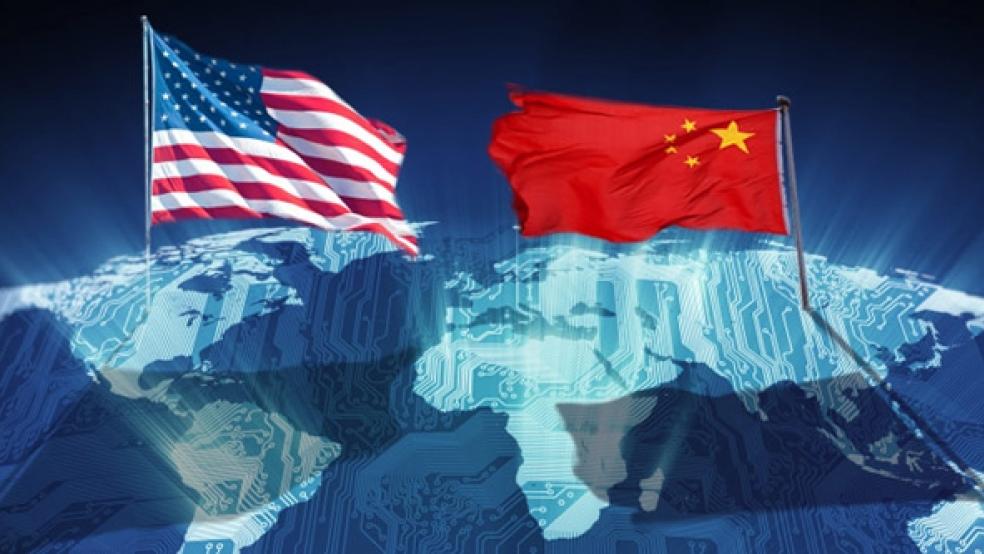There is a simple way to look at the complicated crisis that arises as China presses new claims to jurisdiction over air space above the Pacific.
Beijing’s recent announcement that it will assert rights over a newly declared “air defense identification zone” off its coastline is its latest move in its face-off with Tokyo over who owns some forlorn rocks the Japanese call the Senkakus and the Chinese the Diaoyus. The material dimension of this question has to do with oil and gas deposits beneath the islands, which Japan has long administered.
China has gone from Triple–A baseball to the majors overnight. The airspace claim is not about specks of land and useful resources so much as it is an announcement that China has arrived as a great power and will now—as in right now—take to the field as such.
Related: Chinese Storm Japanese Companies Over 1931 Land Grab
This is it for those of us at the other shore of the Pacific lake: We have a power shift hurtling at us like a very fast fastball.
In addition to the United States, countries with developed economies are lining up to do business with China. China also has a big stake in U.S. debt, real estate and natural resources. A Reuters’ report yesterday claims that China’s factory growth stabilized in November, illustrating the country’s economic resilience. China watchers at Bloomberg have an even rosier picture: For 2014, they predict aggressive growth; more investment in technology, transportation, medicine; more investment in their top universities; more public housing and essential consumer services; and more acquisition of natural resources, especially in Africa.
Jeopardizing this massive restructuring and investment plan over a territorial imperative would be folly.
Washington has been diplomatically correct in staying clear of the very old islands dispute since it intensified several years ago. Although it is committed by treaty to Japan’s security, the sovereignty claim is at bottom a backyard matter. The squabbling neighbors will eventually resolve it, probably by way of a joint-development condominium.
China’s jurisdiction of airspace is otherwise. The commercial air routes running through the zone raise questions for every traveler, but even these are a relatively minor matter.
Washington’s biggest challenge: Can it adjust as China parts the curtain on the power it intends to assert? To resist the mainland’s emergence is to insist that, no, the sun and all the planets really do revolve around the earth no matter what that nut Copernicus says.
The most immediately upsetting spectacle this past week has been China’s insistence that it has a right to identify and monitor aircraft entering its newly declared zone. Planes entering without prior notification could be subject to military action—not terrific at 35,000 feet.
Not to stir morbid memories, but did anyone else think about KAL 007, the fated flight shot down when it flew through prohibited airspace in the Soviet Far East 30 years ago? This is not a moment for reckless flailing.
Related: Washington's Mess Damages U.S. Global Standing
It is a moment to look at a map, for starters, and The New York Times provides a good one. You do not have to be a cartographer to see something wrong. Japan’s airspace declaration is disproportionately extensive, reaching too close to the Chinese coast, too close to Taiwan’s, and too far from Japanese shores. The claims of Taiwan and South Korea are less ambitious but still questionable.
The claims of all three of these American allies were fixed by the U.S. during the Cold War. In effect, The Times’ map depicts an air-traffic controller’s rendering of Washington’s old containment policy in the Pacific.
It is at least a question whether China’s new declaration, also shown on the map, can be legitimately cast as a corrective. And remember, Japan first took the Senkakus as it was extending its empire in 1895; China was on its knees—poor, chaotic, unable to defend itself against anyone, and (most of all) boiling with resentment.
It is plainly inexcusable that Beijing opened up last week by asserting the right to police the zone in question with force. But there are short– and long-term problems before us now.
Turning up the tension by scrambling fighter jets was a clumsy miscalculation on the part of Xi Jinping, China’s militaristic new president. When this gets fixed—and Beijing has already stepped back —the remaining question is what Washington and its Pacific friends will do: Are there new lines on the map or not? What about your next Cathay flight from New York to Hong Kong?
The responses so far have not been much more coherent than China’s stumbling step up the world stage’s stairs. Japan’s commercial carriers were instructed to observe and then ignore and then observe China’s requirement that it be notified of flight plans. At this point, Japan, South Korea, and the U.S. have sent fighter jets into the disputed area without telling Beijing beforehand.
Related: What the Chinese Public Is Saying about the NSA Leaker
At the weekend, President Obama advised U.S. carriers to comply with the rule—a sensible move. But the core question—yes or no or what next as to Beijing’s new idea—remains unaddressed. And anyone who assumes that either Seoul or Tokyo acted without Washington’s assent—if not prodding, we cannot say—is naïve as to how the security structure in the Far East functions.
The biggest mistake was Defense Secretary Chuck Hagel’s order on Tuesday to fly two B–52s through the disputed zone. It was bad strategy and the wrong technology. And it did nothing to sustain U.S. “credibility.” That is best served now with skillful, imaginative diplomacy that is irresistible because it is clear-sighted and right.
On the strategy side, the U.S. cannot assert itself across the Pacific as it once did. This is not a matter of weakness or choice or morality. It is a fact of history. The old security structure was spokes and hub—Washington at the center, all allies reporting in. Relationships are now much denser and power is more diversified, which is a big part of what Xi wants to say.
As to the technology, the B–52s were emphatically a bad idea. Even if bald assertion and confrontation were the right way to go, these huge, eerie birds could hardly have been more insensitively chosen. They have been totemic among Asians since the Vietnam War. They come over from Guam as sinister portents of the aggression of those ever-intrusive Westerners—not the desired message.
At the end of the week, a smart professor and a sometime policy adviser, Shi Yinhong, said something interesting to Jane Perlez, The New York Times correspondent in Beijing. The American bombers, he explained, were “a negative development for a strong, great-power relationship.” Take the cue, White House. You have just been told what this is all about.
Unfortunately, it sounds different when you listen to what comes out of Washington. “For 60 years, the United States has provided a security platform on which Asia's socioeconomic development has been built,” Tom Donilon, Obama’s former national security adviser, said Sunday on ABC’s This Week with George Stephanopoulos. True.
“This has been a long-time role for the United States,” Donilon continued. “And it’s one that we should continue to play and intensify.”
This does not follow. He mistakes yesterday for tomorrow. You do not have to think one way or the other about China to understand that its place as a sharer of power is no one’s choice—not even China’s, in the end.






